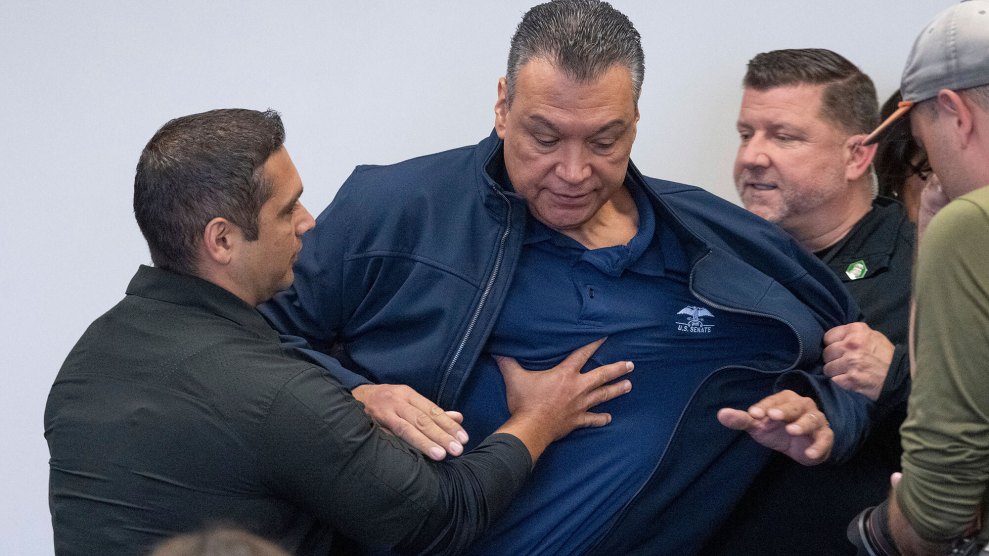US Operation Northern Watch, which has been bombing Iraq regularly since December, has added another weapon to its war chest: laser-guided chunks of concrete. Dubbed “concrete bombs,” these babies weigh 500 to 2,000 pounds each and can take out a military target without explosives, without a rain of shrapnel — and, theoretically, without killing as many civilians.
According to military spokesmen, Saddam Hussein’s armed forces have a nasty habit of locating anti-aircraft artillery and other prime targets directly in residential neighborhoods of Iraqi cities and towns. The strategy is meant to deter US planes from bombing the targets, but it also essentially “forces” US planes to endanger innocent bystanders, the military maintains. Hussein uses images of the dead and injured to turn world opinion against the US bombing campaign there, which makes the military none too happy.
Hence the concrete bomb. With standard explosive bombs, “The blast and fragmentation have a destructive force over a much larger area,” says Federation of American Scientists military analyst John Pike. Bombing a target in a civilian enclave can wreak unintended havoc on homes, schools, and businesses, no matter how accurate the bomb’s guidance system. The laser-guided concrete bomb, by comparison, delivers “precision results with a precision munition,” says Pike.
Concrete bombs have been used for decades for military training and testing, but this is the first time the US has acknowledged their use in combat.
Whether the decision to use concrete instead of explosives is humanitarian or a public relations move intended to counter Hussein’s powerful images of maimed children is debateable.
Operation Northern Watch (ONW) says the reason for the concrete bombs is simple. A spokesman for the campaign said, “We don’t want to see innocent people die.” Hussein Ibish of the Arab American Anti-Discrimination Committee has a different perspective: “The use of concrete bombs just demonstrates the insidiousness of the entire approach … I think that the use of something as strange as a concrete bomb is another indication of how odd and senseless it all is. When you have a campaign of bombing that goes on for years, for no real reason and no real goal, and you have these very weird weapons used,” Ibish says, it indicates that, “you’re looking at a policy that cannot be explained rationally on its face.”
The rationale for bombing Iraq is certainly fuzzy. According to the Operation Northern Watch Website, the operation’s purpose is “enforcing the no-fly zone north of the 36th parallel in Iraq and monitoring Iraqi compliance with UN Security Council resolutions 678, 687, and 688,” which limit Iraq’s weapons programs and condemn internal repression of Iraqis.
No UN resolution ever mandated the no-fly zones or gave the US the authority to patrol Iraqi airspace. In fact, says Ibish, “They’re in violation of all the Gulf War resolutions, which establish the sovereignty and territorial integrity of Iraq.” Says Sarah Sloan of the International Action Center: “The no-fly zones that they’re patrolling are set up unilaterally by the US and England. They’re not even set up by the United Nations.”
An anonymous Pentagon spokesman, however, points to section 2 of UN Security Council resolution 678, which “Authorizes Member States co-operating with the Government of Kuwait … to use all necessary means to uphold and implement resolution 660 (1990) and all subsequent relevant resolutions and to restore international peace and security in the area.” Although the UN did not specifically mandate the no-fly zones, he explains, “UN resolutions give you the broad framework, and the participating nations get together and decide how they’re going to do it.”
Iraqi soldiers have been firing at Operation Northern Watch planes patrolling Iraqi airspace since the December 1998 Operation Desert Fox bombings of Iraq. In response to anti-aircraft fire or radar targeting, US forces have regularly bombed military targets in Iraq over the last 10 months.
While the Associated Press reports that civilian casualties have been minimal, nobody in the Department of Defense wants to confirm that any of the bombing-related 187 deaths and 400 injuries Iraq has reported. An Operation Northern Watch spokesman told the MoJo Wire that the lack of ground personnel in Iraq makes counting bodies nearly impossible. “It’s one thing to fly and spot a big thing of weapons somewhere,” he said. “It’s another thing to fly, get shot at, drop a bomb, try to take evasive action, get out of there, and look to see if a body gets hit …. We couldn’t even begin to give you a number.” US Colonel Bill Darley elaborated, “Most of what we know is what’s reported in the Iraqi press, and we don’t think much of their reporting.”
The one thing the US military will say about any “collateral damage” though, is that any civilian deaths were solely Saddam Hussein’s fault. A Pentagon source (who asked that he not be named) pointed out that the bombing would stop immediately if Hussein would stop shooting at US planes, adding, “As long as they continue to provoke us, they have to expect continued response.” Of course, in some cases, such as an April 25 bombing, Operation Northern Watch planes had merely been tracked by Iraqi radar, without actual anti-aircraft fire.
According to one Operation Northern Watch spokesperson, “We want to make sure [Saddam Hussein] understands that just because he puts something next to a church, or near a mosque, or near a hospital, or near a children’s school, doesn’t mean that we’re not going to defend ourselves and fire at it. And if kids die, or people die, or civilians die, it’s on his head, not on ours.”
“It may well serve his interest to have a few casualties. The cost of life is relatively cheap by his standards,” said our Pentagon source. He even suggested that Saddam may have intentionally bombed his own people, causing the 12 deaths reported by the Associated Press in Jesan on July 19, since Operation Northern Watch’s target was 30 miles away.
Ibish calls this scenario a “very fanciful, highly unlikely fairy tale that derives whatever strength it has from the demonization of a government to the utmost degree.” Whatever Saddam’s degree of media-driven ruthlessness, a military spokesman said that Saddam’s attempts to capitalize from civilian casualties did not spur the use of the concrete bomb. He stated, “The whole reason that we looked at using concrete bombs … is because we are concerned about collateral damage,” and added, “The world isn’t fooled into thinking that he is this poor little victim that is being taken advantage of by the Americans.”
If concrete bombs are, indeed, being used with the intention of saving Iraqis’ lives, then the sentiment is poorly placed, says Ibish. “If it is designed to minimize the suffering of Iraq, that’s ludicrous, because there’s no doubt that hundreds of thousands of Iraqis have died because of the sanctions, and hundreds of people have been killed from the bombings.”
















